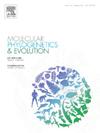系统基因组学和形态学证据支持从竹科(竹总科)中恢复竹属(Clavinodum)。
IF 3.6
1区 生物学
Q2 BIOCHEMISTRY & MOLECULAR BIOLOGY
引用次数: 0
摘要
竹系统学中最棘手的问题之一是关于arundinariieae部落(竹总科:pobusoideae)的三支竹,它们的共同特征是每个中竿节有三个分支。基于双消化限制性位点相关DNA测序(ddRAD-seq)数据的系统发育研究证实,该类群成员Oligostachyum是非单系的,特别是Oligostachyum oedogonatum是一个值得进一步关注的问题物种,因为它在形态和系统发育上与其他三支竹不同。在这里,我们的目标是通过包括其地理范围内的代表来定义和确认O. oedogonatum的系统发育位置。我们还利用多个系统基因组数据集,为三支竹及其近缘属的整体系统发育提供了新的见解。虽然基于质体基因组的树得到的支持很少,但使用两组保守的核基因和单核苷酸多态性(SNP)数据推断的系统发生使用聚结为基础的方法产生了通常得到良好支持和一致的拓扑结构。从最大的串联基因集推断出的树与其他推断最不相似。基于核的数据集都恢复了一个主要的分支,包括所有的三分枝竹和其他四个属,这些属可以与相关的分类群区分开来,因为它们具有每小花三个柱头和瘦形根状茎。值得注意的是,8个O. oedogonatum样本形成了一个分支,与Oligostachyum的其他成员有远亲关系,包括该属的模式种(Oligostachyum sulcatum)。种群遗传方法和基于多种聚结的核数据集分析表明,其中7个居群可视为单一种,但井冈山的1个居群可能是黄精竹与Pleioblastus的属间杂交。在形态上,O. oedogonatum不同于所有其他三分枝的竹子,具有强烈的不对称肿胀的节上脊,一个侧向压缩的小穗,以及在可育小花下面容易断裂的小穗段。由于其形态上的独特性和分子系统发育上的地位,我们建议将其恢复为Clavinodum oedogonatum。我们在这里提供了一个新的单型属的描述。本文章由计算机程序翻译,如有差异,请以英文原文为准。

Phylogenomic and morphological evidence supports the reinstatement of the bamboo genus Clavinodum from Oligostachyum (Poaceae: Bambusoideae)
One of the most intractable problems in bamboo systematics concerns the three-branched bamboos of tribe Arundinarieae (Poaceae: Bambusoideae), which are collectively characterized by having three branches per mid-culm node. Previous phylogenetic studies based on double-digest restriction-site associated DNA sequencing (ddRAD-seq) data confirmed that Oligostachyum, a member of this group, is non-monophyletic, and in particular that Oligostachyum oedogonatum is a problematic species deserving further attention, as it appears to be morphologically and phylogenetically distinct from the other three-branched bamboos. Here we aim to define and confirm the phylogenetic position of O. oedogonatum, by including representatives from across its geographic range. We also provide new insights into the overall phylogeny of the three-branched bamboos and closely related genera, using multiple phylogenomic datasets. While a plastid genome-based tree is very poorly supported, phylogenies inferred using two sets of conserved nuclear genes and single nucleotide polymorphism (SNP) data yield generally well-supported and congruent topologies using coalescent-based approaches. The tree inferred from the largest concatenated gene set is the most dissimilar to other inferences. The nuclear-based data sets all recover a major clade that includes all of the three-branched bamboos and four other genera, which can be distinguished from related taxa due to their possession of three stigmas per floret and leptomorph rhizomes. Notably, eight O. oedogonatum samples form a clade that is distantly related to other members of Oligostachyum, including the type species of the genus (Oligostachyum sulcatum). Population genetic approaches and multi-species coalescent-based analysis of the nuclear data sets imply that seven of these populations can be treated as a single species, O. oedogonatum, but that one population from Jinggangshan is likely an intergeneric hybrid between O. oedogonatum and Pleioblastus. Morphologically, O. oedogonatum differs from all other three-branched bamboos, in having strongly asymmetrically swollen supra-nodal ridges, a laterally compressed spikelet, and rachilla segments that disarticulate readily below fertile florets. Because of its morphological distinctiveness and molecular phylogenetic position, we propose that this taxon should be reinstated as Clavinodum oedogonatum. We provide a new description for this monotypic genus here.
求助全文
通过发布文献求助,成功后即可免费获取论文全文。
去求助
来源期刊
CiteScore
7.50
自引率
7.30%
发文量
249
审稿时长
7.5 months
期刊介绍:
Molecular Phylogenetics and Evolution is dedicated to bringing Darwin''s dream within grasp - to "have fairly true genealogical trees of each great kingdom of Nature." The journal provides a forum for molecular studies that advance our understanding of phylogeny and evolution, further the development of phylogenetically more accurate taxonomic classifications, and ultimately bring a unified classification for all the ramifying lines of life. Phylogeographic studies will be considered for publication if they offer EXCEPTIONAL theoretical or empirical advances.

 求助内容:
求助内容: 应助结果提醒方式:
应助结果提醒方式:


